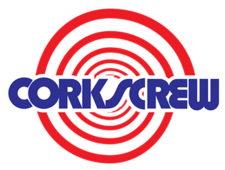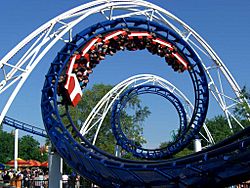Corkscrew (Cedar Point) facts for kids
Quick facts for kids Corkscrew |
|
|---|---|
 |
|

The final inversion on Corkscrew
|
|
| Cedar Point | |
| Location | Cedar Point |
| Coordinates | 41°29′1″N 82°41′7.25″W / 41.48361°N 82.6853472°W |
| Status | Open |
| Opening date | May 15, 1976 |
| Cost | $1,750,000 USD |
| General statistics | |
| Type | Steel |
| Manufacturer | Arrow Development |
| Designer | Ron Toomer |
| Model | Custom Looping Coaster |
| Track layout | Out and back |
| Height | 85 ft (26 m) |
| Drop | 65 ft (20 m) |
| Length | 2,050 ft (620 m) |
| Speed | 48 mph (77 km/h) |
| Inversions | 3 |
| Duration | 2:00 |
| Max vertical angle | 45° |
| Capacity | 1,800 riders per hour |
| Height restriction | 48 in (122 cm) |
| Trains | 2 trains with 6 cars. Riders are arranged 2 across in 2 rows for a total of 24 riders per train. |
|
|
|
| Corkscrew at RCDB | |
Corkscrew is an exciting steel roller coaster located at Cedar Point amusement park in Sandusky, Ohio, United States. It was built by a company called Arrow Development. When Corkscrew first opened in 1976, it made history! It was the very first roller coaster in the world to feature three inversions, which means it turns riders upside down three times.
Corkscrew was also one of the first modern roller coasters to have a vertical loop. Another coaster, The Great American Revolution, opened just seven days before Corkscrew. So, while Corkscrew was a pioneer, Revolution got the credit for being the first with a vertical loop.
Contents
What Makes Corkscrew Special?
Where to Find It
You can find the Corkscrew's station right in the middle of the park. It's across from the huge Top Thrill Dragster ride. It's also next to the Super Himalaya and near the Power Tower. Corkscrew was the first coaster to have inversions with a walkway underneath. This means people could walk right below you as you went upside down!
The Trains
When Corkscrew first opened, it had three trains. Each train could hold 24 riders. They were painted red, white, and blue. This was to celebrate the United States Bicentennial in 1976. Today, the ride usually runs with two trains. This helps keep things moving smoothly.
Riders are held in place by shoulder restraints. These restraints also have seat belts for extra safety. You need to be at least 48 inches (120 cm) tall to ride Corkscrew.
Your Ride on Corkscrew
The Layout of the Ride
Your adventure begins as the train leaves the station. It rolls down a small hill and goes around a 180-degree turn. Then, the train starts climbing the 85-foot (26 m) tall lift hill. This hill is at a 30-degree angle.
Once at the top, the train drops 65 feet (20 m) at a 45-degree angle. You'll reach a top speed of 48 mph (77 km/h)! After the main drop, the train goes over a small hill. Then, you enter the first inversion: a thrilling vertical loop!
Next, the train goes up a short straight section. It then takes a banked 180-degree right turn. This leads you into the next two inversions: the famous corkscrews! These twists take you right over the park's midway. You'll be traveling at about 38 mph (61 km/h) through them. Finally, the train makes a few turns and slows down. It then returns safely to the station.
The Track and Its History
The Corkscrew's track is 2,050 feet (620 m) long. It's made of blue steel tubes. The ride covers about 5 acres (20,000 m2) of land. The whole ride lasts about 1 minute and 40 seconds.
The Corkscrew was designed by Ron Toomer. It was built by Arrow Dynamics. Since it opened in May 1976, over 30 million people have ridden this exciting coaster!
Corkscrew's Records
Corkscrew holds some cool records in roller coaster history:
- It was the first roller coaster to turn riders upside down 3 times.
- It was the first roller coaster to go over a midway (a path where people walk in the park).
| Preceded by Corkscrew (Silverwood) |
First Roller Coaster With 3 Inversions May 1976–March 1980 |
Succeeded by Carolina Cyclone |


